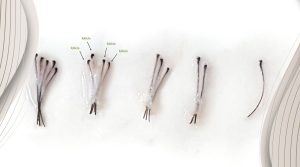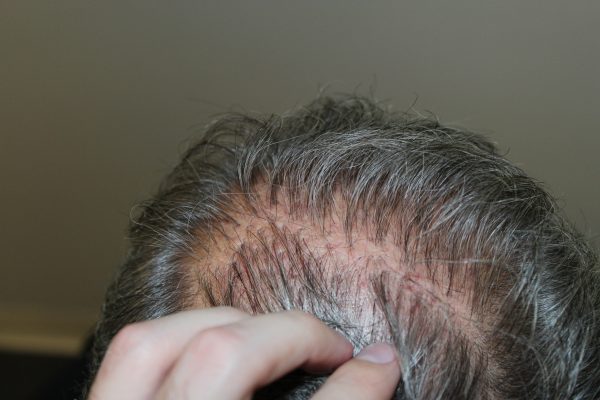Hair transplant plugs were once a common solution for hair loss. However, modern techniques have significantly improved the results and natural appearance of hair transplants. This guide explores the evolution of hair transplant plugs, compares them with newer methods like FUE and FUT, and provides insights into choosing the best options for restoring your hair. For those wondering “what are hair plugs” or if “hair plugs vs hair transplant” is even a valid comparison today, this article provides clarity.
What Are Hair Transplant Plugs?
Hair transplant plugs, often simply called hair plugs, are small sections of the scalp containing hair follicles. Surgeons typically harvested these grafts from a healthy part of the scalp, usually the back of the head. They then moved them to a bald or thinning area. In the past, these plugs were much larger. They lacked the refinement of today’s procedures. As a result, they often created unnatural-looking hairlines, giving a “doll’s head” appearance. This led to many instances of bad hair plugs and failed hair plugs.
The Evolution of Hair Transplants – From Plugs to Precision
The field of hair restoration has undergone a dramatic transformation. This evolution moved away from the noticeable results of early hair plugs towards highly natural outcomes.
From Large Plugs to Micrografts
As methods improved, the size of the grafts became smaller. This allowed for more natural-looking results. By the 2000s, hair plugs became largely outdated. They were replaced by more refined techniques.
The Rise of Follicular Unit Transplantation (FUT)
Follicular Unit Transplantation (FUT) emerged as a major advancement. In a FUT procedure, the surgeon removes a strip of skin containing hair from the back of the head. From this strip, individual follicular units (containing 1-4 hairs) are carefully extracted and then transplanted to thinning areas. FUT offered a significant leap forward in achieving a natural appearance compared to old hair plugs.
The Innovation of Follicular Unit Extraction (FUE)
Today, FUT and Follicular Unit Extraction (FUE) are the most common techniques. FUE involves extracting individual follicular units directly from the scalp, one by one. Both FUT and FUE offer more natural and satisfying results than older methods, making the question of “hair plugs vs transplant” a clear choice in favor of modern techniques.
Understanding Hair Implants vs. Hair Transplants
The terms “hair implant” and “hair transplant” are often confused. However, they refer to distinctly different procedures.
Synthetic Hair Implants – A Banned Practice
“Hair implants” technically refers to synthetic hair strands. These are inserted into the scalp. The idea of instantly getting long hair might seem appealing, especially for hair plugs for women seeking immediate volume. However, these synthetic implants carry serious drawbacks. In the United States, synthetic hair implants are banned due to their high risk of infection, inflammation, and allergic reactions. Modern hair transplants, which use your own natural hair, have made synthetic options unnecessary and undesirable.
Sebum Plugs – A Different Condition
It’s also important to differentiate between hair plugs (a transplant technique) and “sebum plugs hair”. Sebum plugs are a dermatological condition. They occur when excess sebum (skin oil) and dead skin cells block hair follicles, often leading to scalp issues or even hair loss, but they are entirely unrelated to the surgical process of hair transplant plugs or modern hair transplantation.
How Did Hair Transplant Plugs Work (and Their Limitations)?
To use hair plugs, surgeons transplanted a section of scalp from a hair-rich area (donor site) to a balding spot (recipient site). In the early punch graft method, they would remove a small piece of scalp, often about 4mm in diameter. This piece contained up to 30 hair follicles, and they implanted it directly into the thinning area.
However, even after several sessions, the results were often inconsistent. The plugs did not blend seamlessly with existing hair. This created a “corn row” or “doll’s head” appearance, leading to dissatisfaction. This was the main reason hair plugs were replaced. For those asking “how do hair plugs work,” it’s clear they operated on a much cruder principle than today’s methods.

Comparing Hair Transplant Plugs with Modern Techniques
The vast improvements in hair restoration mean that hair transplant plugs are rarely, if ever, used today. Modern techniques offer superior naturalness and patient comfort.
Hair Plugs vs. FUE (Follicular Unit Extraction)
Follicular Unit Extraction (FUE) is a far more advanced method than traditional hair plugs. Instead of removing a strip of scalp, FUE takes individual hair follicles (or grafts) directly from the donor area. This precise method offers several benefits over older techniques:
- Faster healing time: Individual extractions lead to quicker recovery.
- Less discomfort and minimal scarring: Tiny punch excisions are less invasive than large plugs.
- Better for people with lower hair density: Allows for more targeted extraction.
- Versatility: The latest FUE techniques even allow for “no-shave” procedures, making the process more convenient and discreet for some patients.
Hair Plugs vs. FUT (Follicular Unit Transplantation)
In the early 2000s, the FUT procedure largely replaced hair plugs. In FUT, the surgeon removes a strip of skin from the scalp. Then, individual follicular units are carefully extracted from this strip. These follicles are then transplanted into balding areas.
By moving individual follicles rather than larger plugs, the surgeon can achieve a significantly more natural look. FUT is often preferred over FUE when a very large number of follicles need to be transplanted in a single session. Additionally, FUT can sometimes be less expensive and quicker than FUE for high-volume cases.
dvanced Implantation Techniques (DHI & Sapphire Pen)
Beyond FUE and FUT (which are primarily extraction methods), modern clinics utilize advanced implantation techniques that further enhance results:
- DHI (Direct Hair Implantation): This technique involves implanting the grafts directly into the recipient area using a Choi pen without pre-made incisions. It allows for precise control over the angle, depth, and direction of the hair, often resulting in higher density and is suitable for achieving natural-looking hairlines, especially for mens hair plugs concerns.
- Sapphire Pen: This method uses sapphire blades to create micro-incisions in the recipient area.These precise, V-shaped channels allow for closer packing of grafts and can lead to faster healing and less scabbing compared to traditional steel blades.
These modern implantation methods, often used in conjunction with FUE extraction, deliver superior natural results, making old hair plugs obsolete.
Hair Plugs vs. Stem Cell Hair Transplants
Stem cell hair transplants represent a newer, experimental method. In this process, the surgeon removes a small piece of skin from the scalp. Then, follicles are replicated in a lab. Researchers are still studying the effectiveness and safety of this procedure. However, it could become more widely available in the future.
Gender-Specific Considerations in Hair Restoration (Beyond Plugs)
While hair plugs were crude regardless of an individual’s gender, modern hair transplant techniques cater to the distinct patterns of hair loss often observed in different biological sexes.
Hair Plugs for Men: The Evolution of Male Hairlines
Historically, hair plugs for men were a common but aesthetically poor solution for male pattern baldness. These early mens hair plugs often created an unnatural, “doll’s head” appearance, particularly noticeable on receding hairlines and balding crowns. The large size of the plugs meant they couldn’t blend seamlessly with existing hair.
Today, modern techniques like FUE and FUT provide highly natural results for men. Surgeons can meticulously design a natural-looking hairline using single grafts. They can also achieve high density in the mid-scalp and crown. This addresses common male concerns effectively. Advanced methods such as DHI allow for very precise placement, which is crucial for a dense and natural frontal hairline.
Hair Plugs for Women: Addressing Unique Hair Loss Patterns
Hair plugs for women were less commonly performed than for men. This was partly due to different hair loss patterns in women, which often involve diffuse thinning rather than distinct bald patches. When performed, the unnatural look of plugs was equally problematic for women. Additionally, the need for shaving large areas, common with older methods, was a significant barrier for many women.
Modern hair transplantation offers suitable options for women. FUE techniques, including “no-shave” or “partial-shave” methods, minimize the impact on existing hair length. This makes them appealing to women who prefer not to shave their heads. These techniques allow for increasing density in thinning areas while preserving natural length and appearance.
Addressing Concerns – Bad Hair Plugs and Longevity
The term “bad hair plugs” is often used to describe the unnatural aesthetic produced by older techniques. This includes the “doll’s head” appearance or clearly visible rows of plugs.
Failed Hair Plugs and Infection
A failed hair plug procedure means the transplanted grafts did not survive or became infected. “Infected hair plugs” were a significant risk with older, less sterile practices, potentially leading to complications and poor outcomes.
How Long Do Hair Plugs Last?
If the hair plugs (the early grafts) successfully took root and survived, they would grow permanently, just like naturally growing hair. This answers “do hair plugs grow.” However, the main issue was never about their growth, but rather their unnatural look. Modern hair transplants also offer permanent results for the transplanted grafts, which are genetically resistant to balding.
Choosing the Best Hair Transplant Today
After thorough research and consultation, you may decide that it’s time for hair transplant surgery. Choosing the right surgeon is crucial. The hair transplant industry is competitive. It ranges from unqualified operators to highly skilled professionals with years of experience.
Your remaining hair is precious. Trust only the best. Turkey is renowned for its top-tier hair transplant clinics. Skilled surgeons there use advanced techniques (like FUE, FUT, DHI, and Sapphire Pen) to deliver excellent, natural-looking results. For those considering “hair plugs in Turkey” or searching for “turkish hair plugs,” it’s vital to understand that modern clinics in Turkey overwhelmingly offer these advanced methods, not the outdated plugs. This ensures a far superior and more natural outcome than the original hair plugs. Considering “how much are hair plugs” today is misleading, as modern techniques are what’s available and effective.
The hair transplant industry has transformed significantly. It moved from rudimentary hair plugs to sophisticated modern techniques. Having personally undergone thirteen hair transplants, I understand the process well. Trust in proper research and choose clinics with experienced experts. This ensures you’ll be in good hands as you start your hair restoration journey, achieving natural and lasting results far beyond what hair plugs ever offered
Frequently Asked Questions About Hair Transplant Plugs
Yes, if the early hair plugs successfully took root and survived, they would grow permanently, just like naturally growing hair. However, the main issue was never their growth but their unnatural appearance.
Hair plugs worked by transplanting relatively large sections of scalp (about 4mm in diameter) containing up to 30 hair follicles from a hair-rich donor area to a balding spot. This punch graft method aimed to cover baldness directly.
Yes, if the early hair plugs successfully took root, the hair would grow permanently. The transplanted grafts were generally resistant to balding. The problem lay in their poor aesthetic rather than their permanence of growth.
Hair plugs typically resulted in an unnatural aesthetic, often described as a "doll's head" or "corn row" appearance. The large size of the plugs meant they did not blend seamlessly with existing hair, creating a very noticeable and artificial look.
Hair plugs came from the patient's own scalp, specifically from a healthy, hair-rich area known as the donor site. This area was typically located at the back or sides of the head.

